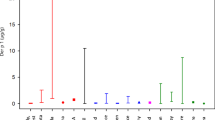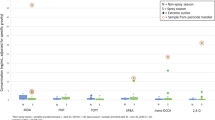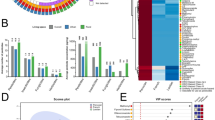Abstract
Background
Women contribute fifty percent of the total work force in tea plantation sector. The continuous use of chemical pesticides in plantation may increase the risk of exposure and can cause detrimental health effects.
Objectives
To assess the health status of women worker exposed to pesticides in tea plantation and to evaluate the pesticide levels in work environment.
Methods
A cross sectional study was performed (n = 204) to assess the health complaints among exposed women workers (n = 116) and non-exposed women (n = 88) using a predesigned questionnaire. Work environmental air samples collected using PUF sampler and personal samplers were analyzed for various pesticides.
Results
Musculoskeletal disorder, skin color changes, allergies and asthma were the most commonly reported health complaints. Notably, only 16% of the women used personal protective equipment (PPE) while 68% reported to have experienced tea plantation work up to 6 month of their pregnancy period. Chlorpyrifos methyl (8.3%), carbendazim (6.7%), thiamethoxam (4.2%), ethion (4.2%) and thiophanate methyl (2.1%) were detected in work place air samples.
Significance
This study is the first to characterize pesticide levels in work place of women workers in India. Women are continuously exposed to pesticides through their work and environmental exposure. Preventive measures are essential to mitigate the adverse health effects of pesticides among women workers.
This is a preview of subscription content, access via your institution
Access options
Subscribe to this journal
Receive 6 print issues and online access
$259.00 per year
only $43.17 per issue
Buy this article
- Purchase on Springer Link
- Instant access to full article PDF
Prices may be subject to local taxes which are calculated during checkout


Similar content being viewed by others
References
Ye M, Beach J, Martin JW, Senthilselvan A. Occupational pesticide exposures and respiratory health. Int J Environ Res Public Health. 2013;10:6442–71.
Dhananjayan V, Ravichandran B. Occupational health risk of farmers exposed to pesticides in agricultural activities. Curr Opin Environ Sci Health. 2018;4:31–7.
Cazé AMB, Lacerda ABM, Lüders D, Conto J, Marques J, Leroux T. Perception of the quality of life of tobacco growers exposed to pesticides: emphasis on health, hearing, and working conditions. Int Arch Otorhinolaryngol. 2019;23:50–9.
Brouwer M, Kromhout H, Vermeulen R, Duyzer J, Kramer H, Hazeu G, et al. Assessment of residential environmental exposure to pesticides from agricultural fields in the Netherlands. J Expo Sci Environ Epidemiol. 2018;28:173–81.
Debela SA, Wu J, Chen X, Zhang Y. Stock status, urban public perception, and health risk assessment of obsolete pesticide in Northern Ethiopia. Environ Sci Pollut Res Int. 2019; https://doi.org/10.1007/s11356-019-05694-x.
Quintana MM, Vera B, Magnarelli G, Guiñazú N, Rovedatti MG. Neonatal, placental, and umbilical cord blood parameters in pregnant women residing in areas with intensive pesticide application. Environ Sci Pollut Res. 2017;24:20736–46.
Van den Berg F, Kubiak R, Benjey W, Majewski M, Yates S, Reeves G, et al. Emission of pesticides into the air. Water Air Soil Poll. 1999;115:195–218.
Forero LG, Limay-Rios V, Xue Y, Schaafsma A. Concentration and movement of neonicotinoids as particulate matter downwind during agricultural practices using air samplers in southwestern Ontario, Canada. Chemosphere. 2017;188:130–8.
JEC. DIRECTIVE 2004/107/EC of the European parliament and of the council, Official Journal of the European Union, L 23/3, 26.1.2005.
Tea Board India. How many pesticides are currently having label claim from CIB&RC for use in tea, 2020. http://www.teaboard.gov.in/TEABOARDCSM/NDQ=.
Sarkar K. Wages, mobility and labour market institutions in tea plantations: the case of West Bengal and Assam. Centre for Development Studies; 2015. http://cds.edu/wp-content/uploads/2015/07/46_Kingshuk.pdf.
Dhananjayan V, Ravichandran B, Anitha N, Rajmohan HR. Assessment of acetylcholinesterase and butyrylcholinesterase activities in blood plasma of agriculture workers. Indian J Occup Environ Med. 2012;16:127–30.
Dhananjayan V, Ravichandran B, Panjakumar K, Kalaiselvi K, Rajasekar K, Mala A, et al. Assessment of genotoxicity and cholinesterase activity among women workers occupationally exposed to pesticides in tea garden. Mutat Res. 2019;841:1–7.
Singh S, Bhutia D, Sarkar S, Rai BK, Pal Joydeb, Bhattacharjee S, et al. Analyses of pesticide residues in water, sediment and fish tissue from river Deomoni flowing through the tea gardens of Terai Region of West Bengal, India. Int J Fish Aquat Stud. 2015;3:17–23.
Dhananjayan V, Ravichandran B. Organochlorine pesticide residues in foodstuffs, fish, wildlife, and human tissues from India: historical trend and contamination status. In Masood F, Grohmann E, Akhtar R, Malik A, editors. Environmental deterioration and human health. Netherlands: Springer; 2010.
Korrick SA, Chen C, Damokosh AI, Ni J, Liu X, Cho SI, et al. Association of DDT with spontaneous abortion: a case–control study. Ann Epidemiol. 2001;11:491–6.
Kumar S. Occupational exposure associated with reproductive dysfunction. J Occup Health. 2004;46:1–19.
Dhananjayan V, Ravichandran B, Rajmohan HR. Organochlorine pesticide residues in blood samples of agriculture and sheep wool workers in Bangalore (rural), India. Bull Environ Contam Toxicol. 2012;88:497–500.
Rajbangshi PR, Nambiar D. “Who will stand up for us?” the social determinants of health of women tea plantation workers in India. Int J Equity Health. 2020;19:29.
CSDH. Closing the gap in a generation: health equity through action on the social determinants of health. Final report of the commission on social determinants of health. Geneva: World Health Organization; 2008. http://apps.who.int/iris/bitstream/10665/43943/1/9789241563703_eng.pdf.
Ngowi AV, Mbise TJ, Ijani AS, London L, Ajayi OC. Pesticides use by smallholder farmers in vegetable production in Northern Tanzania. Crop Prot. 2007;26:1617–24.
Catano HC, Carranza E, Huamani C, Hernández AF. Plasma cholinesterase levels and health symptoms in Peruvian farm workers exposed to organophosphate pesticides. Arch Environ Contam Toxicol. 2008;55:153–9.
Damalas CA, Georgiou EB, Theodorou MG. Pesticide use and safety practices among Greek tobacco farmers; a survey. Int J Environ Health Res. 2006;16:339–48.
Barrón Cuenca J, Tirado N, Vikström M, et al. Pesticide exposure among Bolivian farmers: associations between worker protection and exposure biomarkers. J Expo Sci Environ Epidemiol. 2019; https://doi.org/10.1038/s41370-019-0128-3.
Kudagammana ST, Mohotti K. Environmental exposure to agrochemicals and allergic diseases in preschool children in high grown tea plantations of Sri Lanka. Allergy Asthma Clin Immunol. 2018;14:84.
Larsen AE, Gaines SD, Deschênes O. Agricultural pesticide use and adverse birth outcomes in the San Joaquin Valley of California. Nat Commun. 2017;8:302.
Shaw GM, Yang W, Roberts EM, Kegley SE, Stevenson DK, Carmichael SL, et al. Residential agricultural pesticide exposures and risks of spontaneous preterm birth. Epidemiology. 2018;29:8–21.
Deziel NC, Beane Freeman LE, Hoppin JA, Thomas K, Lerro CC, Jones RR, et al. An algorithm for quantitatively estimating non-occupational pesticide exposure intensity for spouses in the Agricultural Health Study. J Expo Sci Environ Epidemiol. 2019;29:344–57.
Spiewak R. Pesticides as a cause of occupational skin diseases in farmers. Ann Agric Environ Med. 2001;8:1–5.
Nankongnab N, Kongtip P, Tipayamongkholgul M, Bunngamchairat A, Sitthisak S, Woskie S. Difference in accidents, health symptoms, and ergonomic problems between conventional farmers using pesticides and organic farmers. J Agromedicine. 2020;25:158–65.
Thetkathuek A, Meepradit P. Work-related musculoskeletal disorders among workers in an MDF furniture factory in eastern Thailand. Int J Occup Saf Erg. 2018;24:207–17.
Padilla Colón CJ, Molina-Vicenty IL, Frontera-Rodríguez M, et al. Muscle and bone mass loss in the elderly population: advances in diagnosis and treatment. J Biomed. 2018;3:40–9.
Majeed T, Forder PM, Mishra G, Kendig H, Byles JE. Exploring workforce participation patterns and chronic diseases among middle-aged Australian men and women over the life course. J Aging Health. 2017;29:343–61.
WHO. The WHO recommended classification of pesticides by hazard and guidelines to classification: Geneva 27, Switzerland WHO, 2009.
Wang A, Mahai G, Wan Y, Jiang Y, Meng Q, Xia W, et al. Neonicotinoids and carbendazim in indoor dust from three cities in China: Spatial and temporal variations. Sci Total Environ. 2019;695:133790.
Coupe RH, Manninga MA, Foremanb WT, Goolsbyc DA, Majewskid MS. Occurrence of pesticides in rain and air in urban and agricultural areas of Mississippi, April-September 1995. Sci Total Environ. 2000;248:227–40.
Estellano VH, Pozo K, Efstathiou C, Pozo K, Corsolini S, Focardi S. Assessing levels and seasonal variations of current-use pesticides (CUPs) in the Tuscan atmosphere, Italy, using polyurethane foam disks (PUF) passive air samplers. Environ Pollut. 2015;205:52–9.
Carratalá A, Moreno-González R, León VM. Occurrence and seasonal distribution of polycyclic aromatic hydrocarbons and legacy and current-use pesticides in air from a Mediterranean coastal lagoon (Mar Menor, SE Spain). Chemosphere. 2017;167:382–95.
Peck AM, Hornbuckle KC. Gas-phase concentrations of current-use pesticides in Iowa. Environ Sci Technol. 2005;39:2952–9.
Aulagnier F, Poissanta L, Bruneta D, Beauvaisa C, Pilotea M, Debloisb C, et al. Pesticides measured in air and precipitation in the Yamaska Basin (Québec): occurrence and concentrations in 2004. Sci Total Environ. 2008;394:338–48.
Nascimento MM, da Rocha GO, de Andrade JB. Pesticides in fine airborne particles: from a green analysis method to atmospheric characterization and risk assessment. Sci Rep. 2017;7:2267.
Northcott GL, Jones KC. Experimental approaches and analytical techniques for determining organic compound bound residues in soil and sediment. Environ Pollut. 2000;108:19–43.
Muñoz A, Vera T, Sidebottom H, Mellouki A, Borrás E, Ródenas M, et al. Studies on the atmospheric degradation of chlorpyrifos-methyl. Environ Sci Technol. 2011;45:1880–6.
Padovani L, Capri E. Chlorpyrifos-methyl dissipation in a small adjacent water body following application to citrus. Chemosphere. 2005;58:1219–29.
Tomlin CDS. The pesticide manual: incorporating the agrochemicals handbook. Cambridge: British Crop Protection Council, The Royal Society of Chemistry; 1994.
European Union. European Union pesticides database. http://ec.europa.eu/food/plant/pesticides/eu-pesticides-database/public/?eventDhomepage&languageDEN. Accessed March 2020.
EC (European Commission). Review report for the active substance chlorpyrifos-methyl. SANCO/3061/99, 2002. www.atsdr.cdc.gov.
ATSDR-Toxicological Profile: Ethio. www.atsdr.cdc.gov. September 2000. Retrieved 2017; 03–16.
Dhananjayan V, Jayanthi P, Jayakumar S, Ravichandran B. Agrochemicals Impact on Ecosystem and Bio-monitoring. In: Kumar S, Meena RS, Jhariya MK (eds) Resources Use Efficiency in Agriculture. 2020, Springer, Singapore. https://doi.org/10.1007/978-981-15-6953-1_11
Dhananjayan V, Jayakumar S, Ravichandran B. Conventional Methods of Pesticide Application in Agricultural Field and Fate of the Pesticides in the Environment and Human Health. In: K. R. R., Thomas S., Volova T., K. J. (eds) Controlled Release of Pesticides for Sustainable Agriculture. 2020, Springer, Cham. https://doi.org/10.1007/978-3-030-23396-9_1.
Acknowledgements
This study was financially supported by the Science & Engineering Research Board (SERB), Department of Science & Technology (DST), Government of India under the Fast Track Scheme for Young Scientist to Dr Dhananjayan Venugopal (File No: SB/FT/LS-140/2012 Dated 26th April 2013). We are thankful to Dr Kamalesh Sarkar, Director, ICMR-National Institute of Occupational Health, Ahmedabad for his continuous support and encouragement in research and publication. Authors are thankful to ROHC(S) staff, the Deputy Director Health Services, Coimbatore, Tamil Nadu, Block Medical Officer, Valparai, Mrs. Fathima, Village Health Nurse, Primary Health Centre, Valparai Tamil Nadu for their support in biological sample collection in the field.
Author information
Authors and Affiliations
Corresponding author
Ethics declarations
Conflict of interest
The authors declare that they have no conflict of interest.
Additional information
Publisher’s note Springer Nature remains neutral with regard to jurisdictional claims in published maps and institutional affiliations.
Supplementary Information
Rights and permissions
About this article
Cite this article
Venugopal, D., Karunamoorthy, P., Beerappa, R. et al. Evaluation of work place pesticide concentration and health complaints among women workers in tea plantation, Southern India. J Expo Sci Environ Epidemiol 31, 560–570 (2021). https://doi.org/10.1038/s41370-020-00284-3
Received:
Revised:
Accepted:
Published:
Issue Date:
DOI: https://doi.org/10.1038/s41370-020-00284-3
This article is cited by
-
The usage of insecticides and their health impacts on farmers and farmworkers: a scoping review
Journal of Public Health (2023)
-
Geospatial assessment of variations in the heavy metals and pesticides concentration in the agricultural environment of Kasaragod District, Kerala, India
Environmental Monitoring and Assessment (2023)



